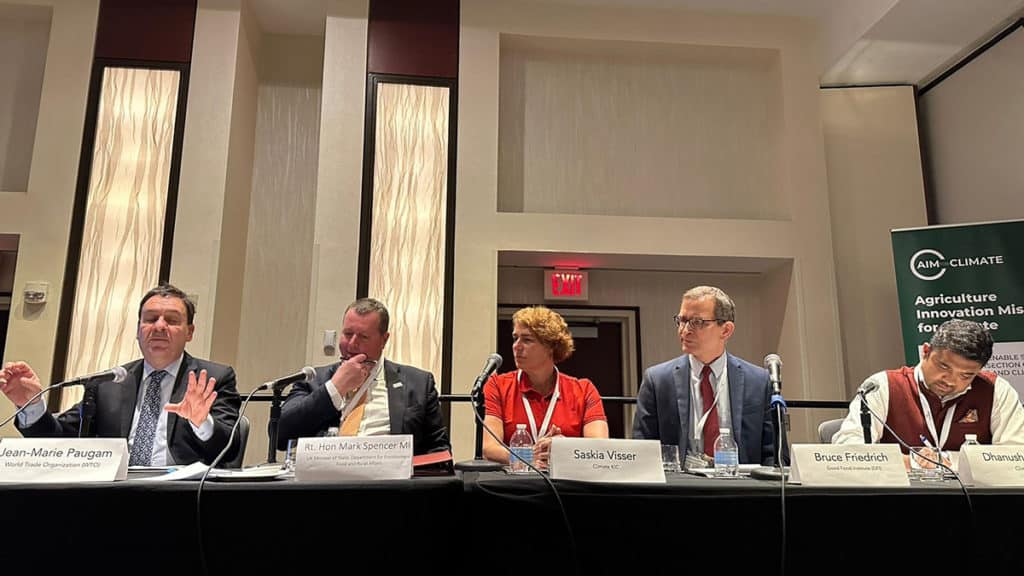El DDG Paugam insta a los ministros a que aprovechen el potencial de la OMC para hacer avanzar la innovación agrícola

El 9 de mayo, con motivo de la Cumbre de la Misión de Innovación Agrícola para el Clima (AIM for Climate) celebrada en Washington, D.C., y organizada por los Estados Unidos y los Emiratos Árabes Unidos, el Director General Adjunto Jean-Marie Paugam destacó el papel de la OMC en el apoyo a la innovación agrícola respetuosa con el clima. Asimismo, hizo hincapié en el potencial del comercio para contribuir a acelerar la innovación agrícola y dijo: “Mi mensaje a los ministros de agricultura es que, por favor, trabajen en estrecha colaboración con sus homólogos de la cartera de comercio para que la OMC consiga los resultados que debe conseguir en apoyo de sus políticas agrícolas con un enfoque climático inteligente”. Más abajo figura su discurso completo.
(de momento sólo en inglés)
I am delighted to join today to provide a trade perspective in this discussion. In the WTO, we value the views of Agricultural experts, national authorities, and international agencies as they are critical sources of knowledge and information to our 164 Members.
We work closely with many of them present in this week’s summit including the FAO, IFPRI, and IICA.
A key point we have learned from them is that the answer to the double challenge of achieving increased productivity and climate sustainable agriculture will be 75% innovation driven. We know this will require investment, technology, and education.
Now how can trade and the WTO help?
The WTO offers a very good framework to support innovation in sustainable agriculture. We manage a trade policy toolbox that can be leveraged to foster innovation worldwide.
The first tool is creating and enhancing access to the global market: It is the most classical one of them all: tariffs. Decreasing tariffs is directly relevant to enhancing access to technology, accelerating the dissemination of innovation, and achieving economies of scale that would incentivise investment.
And this is not just theoretical. We know that we have a global problem of disconnect between tariffs and the climate: several research studies show that tariffs are biased in favour of carbon intensive products, meaning they are lower for «brown» products and technologies as compared to «green» products and technologies. Take alternatives to plastics for example: they are usually taxed with higher tariffs. The reason for that, of course, is that they are derived from agricultural products which are themselves taxed higher.
So, decreasing tariffs is the first thing to consider when thinking about how trade can help.
The second tool is about finance. In essence, the mandate and the goal of the WTO Agreement on Agriculture is to transform «bad» subsidies (those which impact prices and quantities and distort competition), into «good» subsidies. Symbolically enough we refer to these green subsidies as «green box» measures, because they cover all the subsidies that are needed to foster innovation and, of course, they include innovation in climate smart agriculture. Infrastructure, research, extension and advisory services, education, and support to farmers’ incomes all come under the Green Box. And it also covers support under the environmental programmes themselves.
We have a financial pot which globally amounts to approximately USD 600 billion of agricultural support to producers, out of which nearly USD 400 billion are heavily trade distortive. So we urgently need to reduce this amount and channel it toward “good” subsidies. Some of our members are already talking about the need to “repurpose” agricultural subsidies toward the fight against climate change. While there is currently no consensus on this issue at the WTO, I’d like for you to think about is: what could we do with this money to support better productivity and climate smart agriculture?
The third tool is about regulation. We maintain in the WTO a science-based framework to provide predictability when our members apply sanitary and phytosanitary measures to agricultural products. It helps foster daily discussions and cooperation initiatives between our members. Here again, there could be options to consider for better using this regulatory framework to increase support to climate smart agriculture. There are other elements of our regulatory framework which could also help. For example, our trade facilitation agreement helps countries reduce transaction costs for companies accessing various international markets.
So we have all these tools. I would like to add that they are very flexible. This is no “golden straight jacket” nor “one size fits all” approach. The WTO framework allows for granular arbitrages between industrial, environmental, or social concerns. It provides policy space to developing countries, including food insecure countries so that they implement investment policies in their agriculture sector and adapt their trade policy according to their specific circumstances.
Now do we use this framework efficiently to foster international cooperation in favour of climate smart agriculture and innovation?
The answer unfortunately is not exactly. On market access and subsidies reform, our negotiations have stalled for almost three decades On SPS regulation, we’ve made much better progress as we are currently engaged in useful discussions, including on climate change and food security.
But overall, we lack consensus on all these issues at the WTO. One of the main reasons is that we have so much unfinished business from the past, including trade distorting domestic subsidies. And this has prevented our members from tackling the critical issues impacting agriculture today and into the future – such as climate change and climate smart agriculture.
Today we have one emerging topic that could help us bridge the gap and that is food security: food security is obviously at the heart of the conundrum between production, trade, and climate change. The United States amongst other recently presented an interesting contribution to the WTO on that topic. So, I hope that it may build the needed bridge between the past and the future. My message today to Ministers of Agriculture is, please push together with your trade counterparts for the WTO to deliver what it should be delivering in support of your climate smart agricultural policies.















